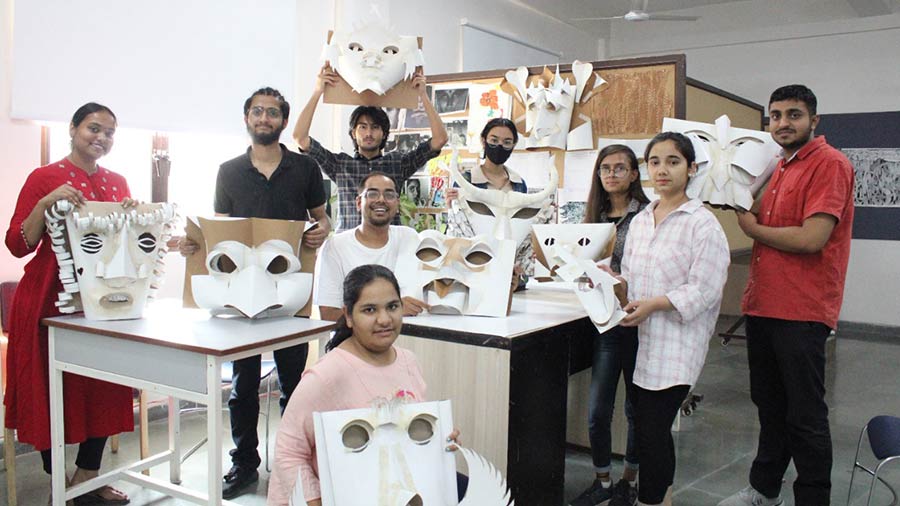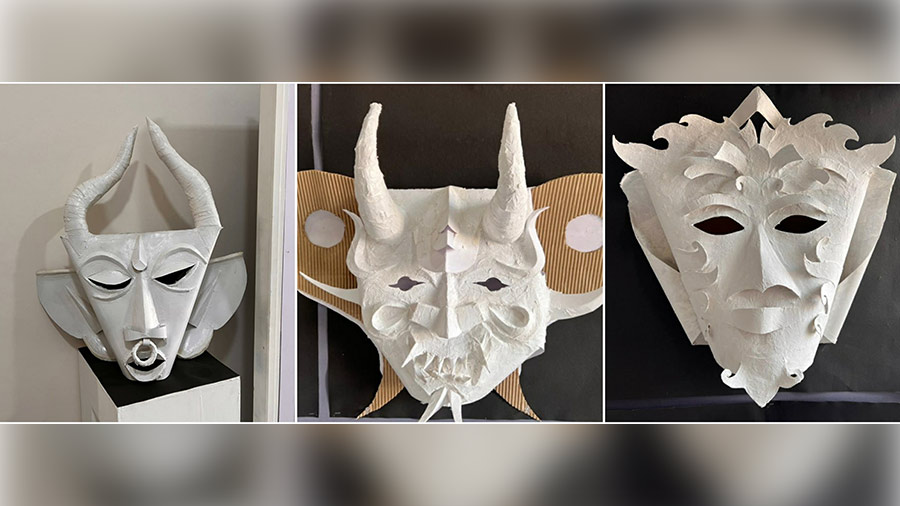From Indian classical dance forms to theatre, the art of traditional mask-making has been a prominent medium to showcase an array of emotions. An alumnus of Visva-Bharati and Indian College of Art and Draftsmanship, Sumit Sarkar is a visual artist who specialises in traditional mask-making and has been trying to make students aware of this art form.
Sarkar, an assistant professor at the Visual Art School of World University of Design, Delhi, spoke to My Kolkata about why he is fascinated by traditional mask-making and how it inspired him.
Inspiration behind mask-making
As a child, Sarkar visited various museums and fairs where the masks would intrigue him. “I would come back home and try to make them on my own. The masks that are used in Chhau inspired me as well as those of deities. I found it interesting the way masks of asura portrayed different emotions. Durga, too, fascinated me,” he said.
At art college, Sarkar had to make masks as a part of the curriculum. “We were asked to make masks with clay. Later, I kept experimenting by changing the medium to papier mâché and mount board. Slowly, I started putting in my own styles, yet there would be a touch of tradition in it.”
Popularising mask-making among youth
As a teacher, Sarkar conducts workshops in colleges around the world to keep the art of mask-making alive.
“When I was teaching at Green Wave Centre for Visual Art in Kolkata, there was an art fair where we had a workshop on mask-making. Students from schools and colleges took part in it. I gave the students a mount board and asked them to make masks out of it. They could use their creativity to use things on the base. The students were all very interested in the workshop as I showed them various kinds of masks from all over the world.”
Sarkar introduces students to various kinds of masks in his workshops. “Masks wonderfully portray human aspects, emotions and expressions. African masks were often made of animal skeletons and that conveyed the message of power. Likewise, I try to show students how masks were used earlier and how they are utilised now. The medium has also had a journey for different masks. The medium and materials in the ancient times were sourced directly from nature,” Sarkar said.

Sumit Sarkar with students of World University of Design.
Sumit SarkarThe artist believes that mask-making can help students be more creative. “In the university where I teach (World University of Design), students are already very aware of mask-making. I held a workshop here in July and realised students wanted to do more with masks. They are designing masks and are converting them into designs for their textile. They are thinking anew again.”

Masks made out of mount board.
Sumit SarkarIndian traditional masks
Sarkar says masks can be categorised by their place of origin. “There are different types of masks in India in different states, most are based on deities as well as on animals.”
“Assamese, Chhau, Himachali and Karnataka metal masks are some traditional masks of India. Then there are African, Sri Lankan and Cuban masks, each of these creations is designed according to the particular traditions of their region. Male dancers would wear masks as they strode with dignity. Some masks were intended to shock or horrify, others to astonish or to make audiences laugh,” Sarkar said.
Sarkar goes far and wide with his masks
The professor says masks have helped him learn how to express himself without hesitation.
Sarkar is a prolific painter with five years of experience. He explores art with various contemporary objects and materials as medium. He has taken part in various national and international art projects. He has held exhibitions in Scotland, South Korea and Italy and participated at art expos in Thailand, Dubai, Beijing, Dhaka held biennially.
He attended Beijing (2017), Bangladesh (2016) and South Korea (2020) art biennales. He represented Indian culture and contemporary Indian art through his paintings. He also won the second prize in the practitioner category at the art exchange programme in Thailand in 2020. He was also awarded Kala Sakshi Memorial Trust Award in 2015 by the Bombay Art Society. The Late Sanjay Haridas Jagdale Award for Best Entry, Mumbai, between 2015 and 2016 was also bestowed upon him. He was also awarded the Ministry of Culture [NHRD] Scholarship to Young Artists in the painting category.






